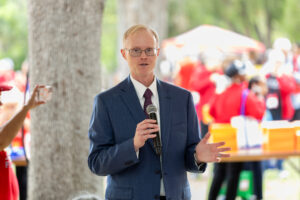Executive Summary:
- The Senate Finance committee received budget recommendations from the Legislative Budget Board about the Teacher Retirement System of Texas.
- The committee received testimony from TRS Executive Director Brian Guthrie and TRTA Executive Director Tim Lee.
- In the absence of additional funding, Guthrie explained TRS-Care would cease to exist.
- Lee offered retirees’ assistance to solve the budget shortfall, but asserted that the contribution levels from all sources must be raised to ensure the fund’s solvency.
On January 24, 2017, the Senate Finance Committee met to discuss several state budget items, including requests from the Teacher Retirement System of Texas (TRS) for the pension fund and the TRS-Care retiree health insurance program.
The committee began its budget discussions with Article III, which includes all agencies affiliated with education. Chairman Jane Nelson (R-Flower Mound) is a former teacher, and she explained her reasoning for beginning budget discussions with Article III.
“Public education is critical to the future of our state,” said Nelson.
The members of the Senate Finance Committee are: Sen. Jane Nelson, Chairman; Sen. Juan Hinojosa, Vice-Chairman; Sen. Paul Bettencourt; Sen. Brian Birdwell; Sen. Kelly Hancock; Sen. Joan Huffman; Sen. Lois W. Kolkhorst; Sen. Robert Nichols; Sen. Charles Schwertner; Sen. Kel Seliger; Sen. Larry Taylor; Sen. Carlos Uresti; Sen. Kirk Watson; Sen. Royce West; and Sen. John Whitmire.
Testimony about TRS began with Trevor Simmons of the Legislative Budget Board (LBB), reporting an overview of the TRS Legislative Appropriations Request (LAR) submitted in August 2016. You can read the TRS LAR for fiscal years 2018 and 2019 here.
As part of the request submitted by TRS in August 2016, an exceptional item for retiree health funding in the amount of $1.35 billion above the standard 1 percent of aggregate active teacher payroll from the state was included.
“Our request includes funding for the 1.0% contribution and assumes covered payroll growth of 3.5% for the public education sector. Additionally, TRS is requesting an exceptional item in the amount of $1.35 billion to provide for fiscal solvency through the end of FY 2019.”
The TRS-Care budget shortfall’s amount has decreased since August, and is now expected to be about $1.1 billion. Last week, when the Senate filed its budget bill (read SB 1 in its entirety here), no exceptional items or extra funding to ease the TRS-Care shortfall were included.
Simmons said TRS would need $4.8 billion for the biennium to fund the pension trust fund and the health insurance programs, including TRS-Care and TRS-ActiveCare. This amount is approximately $400 million more than last session, a number that has grown due to active educator payroll growth.
The state contribution to the pension fund is set presently at 6.8 percent of active payroll, while the state contribution to TRS-Care is set at 1 percent of active payroll. The LBB reported that payroll in public education has grown an estimated 3.5 percent. The 1 percent for TRS-Care is equivalent to $650 million for the 2018-2019 biennium.
The LBB reported that a rider prohibiting retiree premiums from increasing had been deleted from the Senate budget bill, SB 1. The rider had been in place for multiple sessions prior to its removal. The LBB also said there are five funding sources that can be manipulated to impact TRS-Care financially: state contribution rate, active member contribution rate, school district contribution rate, retiree premiums and benefit reductions.
Senator Kirk Watson (D-Austin) brought attention to the fact that retirees are already paying $1.4 billion in premiums and out-of-pocket expenses.
“Retirees are already contributing more than the state,” Watson said. “State contributions are tied to payroll growth . . . there is no relationship to the cost of health care we are buying with TRS-Care.”
Watson then asked if there is a better way to tie the state’s contribution to the program than through payroll.
Senator Joan Huffman (R-Houston) reminded the committee members that during the 84th Legislative Session in 2015, TRS-Care faced a shortfall of $768 million, which was covered by the state, in addition to the 1 percent contribution. Watson agreed, saying, “we filled in a little more of the hole, but we’re still behind.”
“It was a plug but not a fix, and we have got to fix this,” Nelson responded.
Earlier in the week, Nelson created a work group specifically to look at funding issues with all state-vested health care programs. “I am hoping the work group will do an in-depth look at what is driving these costs and what we can do about it.”
The following Senators will serve on the workgroup: Charles Schwertner, Chair; Joan Huffman; Lois Kolkhorst; Robert Nichols; Carlos Uresti; Kirk Watson; and John Whitmire.
The LBB provided a hypothetical funding scenario showing proportional increases by all of the different contributors to TRS-Care, suggesting the state increase by 50 percent to 2 percent of payroll, school districts and actives increase by 12 percent, and retiree premiums increase by 25 percent. They emphasized that this scenario would apply to covering the shortfall cost only, and would not provide a long-term funding solution. If this scenario were to occur, it would be a cost of $673 million to the state.
Brian Guthrie, Executive Director of TRS, followed the LBB’s presentation, providing an overview of the pension fund, which now has $134 billion held in trust for 1.5 million active and retired members. “One out of every 20 Texans is a member of TRS,” he said.
TRS received a 7.4 percent rate of return on investments in 2016, while the agency’s assumed rate is 8 percent. Senator Charles Schwertner (R-Georgetown) expressed concern about the assumed rate of return, while Guthrie explained that the agency uses a long-term projection of at least 15 to 20 years to determine if its return assumption is reliable. Guthrie also reported that by 2047, TRS projects the unfunded liability will be paid off, assuming the 8 percent rate of return and that contribution rates from the state, active members and school districts remain the same.
Guthrie provided an overview of TRS-Care, a program that now has more than 250,000 participants. Reiterating a sentiment shared by Watson and the LBB earlier, Guthrie pointed to active teacher payroll not keeping pace with health care coverage costs.
“There is a fundamental disconnect in the funding for TRS-Care and the actual cost of health care,” Guthrie said.
Senator Huffman asked Guthrie to explain the reason Medicare-eligible retirees cost TRS-Care significantly less than non-Medicare-eligible retirees. For example, a non-Medicare participant in TRS-Care 3 costs $14,000 per year, while a Medicare Advantage enrollee in the same level costs $3000 per year. Guthrie explained that the majority of Medicare-eligible retirees’ costs are covered by the federal Medicare program, and TRS-Care functions as a supplement.
According to Guthrie, TRS-Care funding has been an issue for several sessions, and as time goes by, the options for resolving the problem become fewer and fewer. “We have very few tools left to address this issue,” he said.
Guthrie also reminded the committee members that “increasing premiums on retirees with fixed incomes has a fundamental impact on their ability to survive.” The TRS Board of Trustees has done everything it can that is within its purview to save money, including introducing the Medicare Advantage program two years ago and raising retiree out-of-pocket costs and deductibles in September 2016.
If the committee does not make any changes to TRS-Care, TRS’s only option would be to raise premiums for retirees using TRS-Care 2 and 3, effectively quadrupling them. TRS expects many retirees would cease to use levels 2 and 3, opting instead to go to the catastrophic plan, TRS-Care 1, which is provided at no cost to the retiree by state law. TRS-Care would no longer be sustainable, and TRS would be forced to begin closing the program altogether.
“TRS-Care would last for maybe two years and that’s it, it’s gone,” said Guthrie.
Huffman chaired the interim committee responsible for studying TRS-Care. She warned committee members that solving TRS-Care would not be an easy task.
“There are options . . . it will cause some pain, more so for people 65 and under, and it does not go without more cost to the state,” Huffman said.
Schwertner, who will chair the newly created work group on health care and is also a medical doctor, asked Guthrie if TRS has changed benefit designs, limited its networks and tried to manage costs by limiting benefits. Guthrie said that TRS has done all three of those things in varying degrees, and has also looked at providers and tried to steer members to the most economical options.
Schwertner expressed his concern over the cost differential between Medicare and non-Medicare participants.
Following TRS’s testimony, time was allowed for public comment. TRTA Executive Director Tim Lee told committee members that Medicare actually pays for $1.6 billion of TRS-Care’s program costs. By having a health care network through TRS, the state and retirees additionally save $940 million.
It is clear from the meeting that in order for TRS-Care to survive, everyone will need to pay more. As Tim Lee stated, “money is necessary to save this program, and retirees are ready to come to the table to discuss premium and benefit adjustments.”
However, Lee restated the need for all parties to increase funding to protect the program. Retirees want to do their part and are ready to do so, but are limited in what they can afford. TRTA is asking the Legislature to prioritize TRS-Care this session, and to develop long-term solutions that include additional state and employer contributions.
Lee also addressed concerns by some Senators about the stability of the TRS pension fund. During the meeting, some Senators openly discussed moving the fund to a defined contribution plan. However, Huffman made a point to compliment TRS’s work.
“I think it’s really important for the committee to differentiate between TRS-Care and the very healthy pension system that the Teacher Retirement System actually is,” Huffman said.
Lee echoed Huffman’s sentiments by praising the retirement system for its great work in managing the defined benefit pension fund.
TRTA is ready to discuss options such as health care containment with the Senate work group, and there is hope for increased savings to the TRS-Care program. However, these efforts alone will not solve the shortfall. More appropriations are necessary to resolve the current shortfall, and keep the program sustainable for the future.
We can solve the TRS-Care crisis, but it will take all of us working together!
Gracias
Thank you for your membership to TRTA. If you are not yet a member, we need you to help us protect your retirement security. Please join TRTA today!
Asegúrate de Danos like en facebook, Síganos en Twitter y suscríbete a nuestro canal de youtube.



